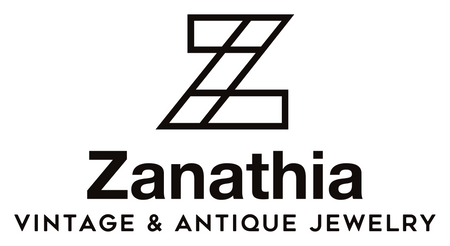
When I first began curating antique jewelry, sometimes it would be challenging to authenticate antique period-era items from reproduction styles. There is nothing wrong with replica styles and paying homage to original pieces, but collectors like myself are in love with actual memory-filled historic jewelry from the past. Authentic vintage jewelry styles are often inspired by earlier times, such as the Victorian-Revival era of the 1970s and '80s. These Victorian-Revival era pieces are at least 30-40 years old and were designed to resemble jewelry from the original Victorian era (c.1837-1901). As the years and generations go by, older accessories are becoming rarer and more sensitive to preservation. It is fascinating for me to discover an original century-old antique piece that is still in good condition. I often feel like an archaeologist on a treasure hunt, with a mission to preserve history with memory-filled jewelry. Generally antique jewelry is usually at least 100 years old. As time passes and eras pass, what is considered antique will inevitably change. Therefore, the descriptions and characteristics of an 'antique' will also broaden. Here are a few tips and information I've learned from treasure hunting, collecting, and researching antique jewelry.
Brooches/Pins
- Look for trombone hinges, tube hinges, and c-clasps on brooches and pins. These pins were generally used from the 19th century to the early 20th century. The trombone clasp (shaped like the instrument) was patented in Europe in 1850 and was usually handmade. Both the tube and c-clasp hinge were created in 1850 and were typically handmade. Most Victorian brooches/pins have a c-clasp.
- Around 1890, the safety catch was invented to better secure brooches and pins. Early safety catches were handmade. Victorian Era brooches/pins usually have simple handmade clasps.
- Tongue and groove safety catches were invented during the Edwardian Era, around 1910. Most Victorian brooches do not have a tongue and groove catch. However, there are Victorian bracelets that have simple spring-ring clasps and box catches that are similar to tongue and groove safety fasteners. The longer the pin is, the older the brooch/pin. Examine how far the pin extends beyond the catch. However, many antique 19th-century pins also can extend the exact distance of the net as
 (Pictured above is a backing of an Antique Art Nouveau Era Sash Brooch with a safety pin that extends beyond the catch)
(Pictured above is a backing of an Antique Art Nouveau Era Sash Brooch with a safety pin that extends beyond the catch)


Earrings:
- Victorian pierced earrings usually had long simple looped wires for pierced ears or threaded posts. Screw-backs for non-pierced earrings were invented during the 1890s and patented in 1894. Hinge-wire Victorian earrings were usually associated with European jewelry. The wire would be inserted from the back of the ear and fastened at the front.
- During the early Art Deco Era, post and clutch earring backings were created (c.1920). Identifying antique and vintage earrings can be a little more challenging since some of the licenses and designs were also commonly used in later vintage jewelry periods.
Bracelets/Necklaces:
- The joint spring ring clasp was introduced in the late 1890s. An older rounded spring ring clasp without a thumb knob was standard in some older Victorian jewelry.
- The pin and barrel clasp was standard during the Victorian Era.
- The hook and box clasp was seen on necklaces and bracelets during the early 20th century, circa the 1920s.

(Pictured above is an Antique Victorian catalog from S.F Myers and Co (1889). This is a good source for comparing other antique bracelets with a similar or general style. Hinge bracelets were standard during this era as well.)
Materials/Manufacturing/Hallmarks:
- Examine the different types of materials, designs, and stamping methods commonly used in period jewelry.
- Carved jet was a popular choice for Victorian-era Mourning jewelry. It was first mined in Whitby, England. It is now illegal to drill a jet. Therefore, any natural jet jewelry indicates that the piece is an authentic older antique from the Victorian Era.
- Art Nouveau jewelry (c.1890-1915) used many semi-precious stones like Amethyst and opals with designs such as butterflies, fairy-like women, and nature themes.
- Hallmark and metal purity stamping varies for different countries and regions. For example, the term 'sterling' was used in the U.S.A after 1870 but was not commonly stamped on antique English jewelry. Before 1870, the U.S.A used the 'coin silver' standard (900/1000), which is lower than sterling (925/1000) silver. Most antique jewelry will not have the '925' marking on sterling pieces. If an item were marked sterling, it would likely say 'Sterling,' 'STER,' or 'STG.'
- If a jewelry piece is marked 'Czech' or 'Czechoslovakia,' it is not a 19th-century antique. The country of Czechoslovakia was formed following World War 1 in 1918. Therefore, most antique 'Czech' jewelry was created during the Art Deco.
- Carat markings differ depending on the country. In Britain, carat is spelled with a 'c'; in the U.S, karat is spelled with a 'k.' This is beneficial to find the country of origin in antique jewelry if there are no other markings or hallmarks on the piece.
- Bakelite, the first synthetic plastic, was created in New York circa 1907. Therefore, any antique Bakelite jewelry cannot be from the 19th century and is post-1900s.
- Most stones during the 19th century were hand-cut rather than machine-cut. Machine stone cutting was invented during the 1900s. Before the 1900s, stones were set by hand, like the rose cut of the Georgian and Victorian Eras.

